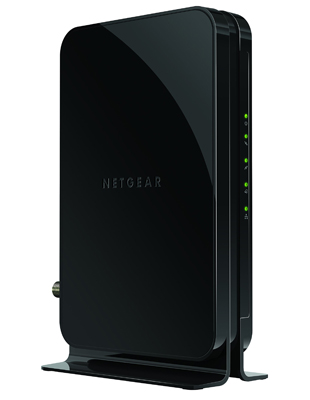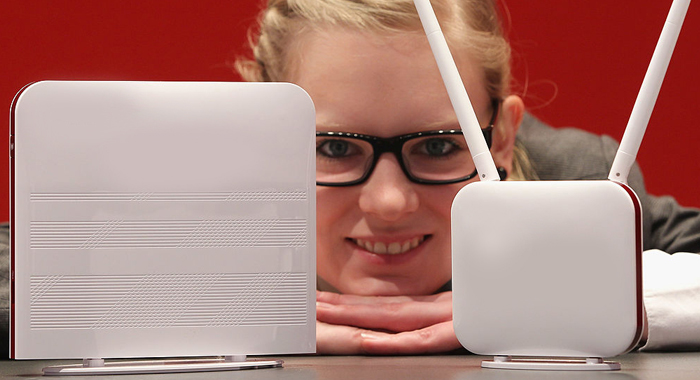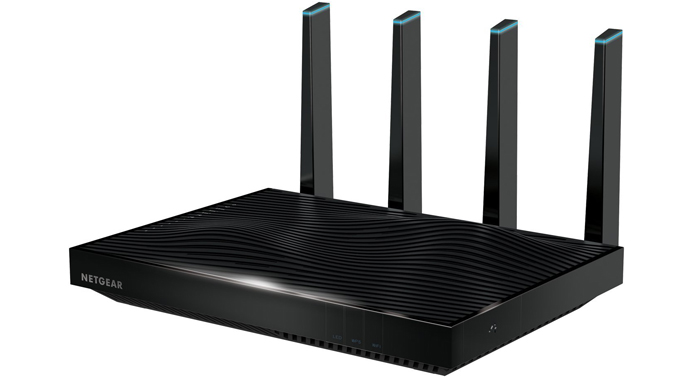We’ve provided primers on streaming boxes and live TV streaming services, and there’s a wealth of info here on RT about which movies are the hot ones to rent online or through FandangoNow, but there’s one very important thing you need to know to get the most out of your digital life. It’s the one thing potentially bottlenecking your whole experience, and it’s probably one of the most boring things you can talk about that is absolutely necessary to get right: your modem.
Part of the problem is that you may be so used to what you’re getting that you don’t realize there is an issue to begin with. Videos buffering; Netflix streams or YouTube videos pausing multiple times while you’re trying to get your binge on; things slowing to a crawl if you have multiple people in your home online at the same time — sound familiar? You even went out and bought a new router, which helped somewhat. But the single most important factor in the speeds you’re getting today is the appliance through which the internet actually enters your home. The following are three things you can do right now to increase your speeds and the quality of your throughput.

Some of you may have already experienced this, but for everyone who hasn’t, your modem may be due for a free upgrade. You’re paying a monthly rental fee for your modem on many internet service providers (ISPs), so it’s their job to supply you with the most up-to-date equipment for the service they provide. In this case, many residential users have been on DOCSIS 2.0 (Data Over Cable Service Interface Specification 2.0), while most of the cable internet industry has moved on to DOCSIS 3.0, enabling faster speeds and more simultaneous streams of data. Google your modem’s model number and see if you’re still using a DOCSIS 2.0 modem. If so, get your equipment updated to the latest. In most cases, this will be as simple as you taking your old equipment into your ISP’s offices and swapping it out for the latest kit. Why should you do this? The older modem was capable of speeds which are now outdated compared to what your service provider now offers, but most importantly, those speeds may be slower than what you’re actually paying for. Now, in many cases, as providers have upped their plans and speeds, they’ve swapped out old equipment, but this is our PSA for the rest of you who either didn’t know about this or have yet to do it: swap it out. Trust us — it can make a noticeable difference.
I know a lot of people enjoy plug-and-play action. You just want to pick up that gadget or service and it just works, no muss, no fuss. So why would you want to buy your own modem instead of allowing the cable company to provide you with theirs? You’re thinking that if you do it that way, you don‘t have to deal with any compatibility issues, and you don’t have to worry about figuring out which modem actually works with your service. Makes sense, right? Not necessarily.
A cable modem is actually a fairly basic piece of equipment as far as user-friendliness goes. Choosing the right piece of equipment should mean that you have to do nothing more than connect the coaxial cable to the modem, then connect the modem to your router via ethernet cable. The true incentive here is cost savings. Let’s look at Spectrum, for instance. If you’re on an internet plan with Time Warner/Spectrum, you’re likely paying $10 a month to rent that modem, or $120 annually. Most of the modems you can buy from your brick-and-mortar or from an online retailer will run you around $80. So, in eight months you’re breaking even, by the end of the year you’re already halfway to the thing having paid for itself.
 |
“But what do I do when the next internet speeds come out and I need a new modem?” That’s a fair question. I’d say that by the time the next standard is actually rolled out and available to enough consumers, that you’ll have paid for the cost of the purchase of your current modem two or three times over. In other words, you’ll be fine. It took some time for the industry as a whole to move from DOCSIS 2.0 to DOCSIS 3.0, and I think it’s safe to presume that the move to DOCSIS 3.1 will take a bit as well. 3.1 is the standard which will support gigabit (1000Mbps) download speeds, and right now, companies that have rolled out gigabit internet include the modem as part of the plan.
There are only two reasons why you won’t want to purchase your own modem: you’re using fiber or DSL (Google Fiber or Verizon Fios, for example), or your cable provider is also providing you with your phone service. You could purchase your own eMTA (telephony) modem but it will be more expensive than your standard modem. For example, the Arris Touchstone TM822G DOCSIS 3.0 telephony modem will cost you $170 from Amazon.
To quote G.I Joe, “Now you know, and knowing is half the battle.” The other half of this particular “battle” is knowing which modem to buy, so I’ve done your homework for you. Since I don’t have every cable service at my disposal, I’ve added to my own testing the results from other blogs I read when I need supplemental data, and I’ve pored over Amazon reviews. Fortunately, there aren’t many modems, so that makes choosing one easier, and the ones that are available seem to be relatively problem free, according to the large volume of reviews out there.
The Arris SURFboard SB6183 and Netgear CM500 are both top picks on Amazon with the former being “Amazon’s Choice” and the latter being the “#1 Best Seller” with 4.5 stars and over 5,700 reviews. So, what’s the difference? It’s all about the warranties, so you should know that Arris’s modem comes with a two-year warranty, while Netgear’s unit is backed by a one-year warranty. If you’re a Time Warner Cable (now Spectrum) subscriber you’re going to have to go with Netgear because of something called IPv6, which isn’t supported by that ISP on the Arris modem.
Why these two modems? Besides being widely reviewed, both by tech sites and users on Amazon, both modems feature support for 16 downstream and four upstream channels of data. Think of each stream like its own connection directly to your ISP. This is especially handy if you’re a large family, or an especially techy user, and have a dozen or more devices connected to your network at any time. If one channel is congested, your son’s Minecraft session can access another, thus keeping your Voltron binging over your Arris modem swift as the Red Lion. Princess Allura would be proud!
There are modems with more downstream and upstream channels that support faster speeds, but you aren’t going to gain much in the way of speed right now, as those faster products support DOCSIS 3.1. Stick with the 16×4 modems and leave the 32×8 modems on the shelf (or webpage) for now.

Sean Gallup / Getty Images
Ok, so you have an updated modem. What now? You’re going to need a router to get internet connectivity to all of the devices in your home. There are many routers on the market, available at various price points and with a fairly broad array of features, so I’m going to distill that down to a few options based on cost and size of space and family. A couple options include Netgear products. They have a vulnerability to internet attack which was just recently discovered, so the first thing you’re going to need to do once you get them up and running is run this patch.
Under $150 (Great for spaces 2000 sq.ft. or less, singles and small families.)
The “#1 Best Seller” on Amazon currently is the TP-Link Archer C7 router. This is a dual band AC1750 router that comes with a two-year warranty and four gigabit ethernet ports, and it supports up to 450Mbps on its 2.4GHz channel and 1300Mbps on it’s 5GHz channel. What’s most important, according to a review on The Wirecutter, is that it outdistances more expensive routers by quite a measure, keeping things speedy even through walls at the farthest reaches of sub-2,000sq.ft. homes. The true test of a router.
This next router scores high marks on Amazon with 4.5 stars over 3,300 reviews, and gets great reviews around the web. I’ve owned a previous generation version of it for some time now. Netgear’s R6400-100NAS AC1750 Nighthawk comes with many of the features you’ll need in a modern router. Best of all, you can get this on Amazon as a bundle with the Netgear CM500 modem (mentioned above) for $203.44. Unlike TP-Link’s model, this one comes with two USB 3.0 ports, instead of USB 2.0, which is particularly handy if you’re planning on attaching any external hard drives or flash drives to the unit.
Under $400 (Spaces over 2000 sq.ft., techy users and mid-size to large families with multiple devices per person)

Netgear’s Nighthawk line is one of the best in this space. You’re going to get speed and coverage with the Nighthawk X8 R8500 but the reason you go with the R8500 is load. Let’s say you’re a family of five and particularly tech-savvy, e.g. two adults and three tweens in the house, and everyone has a smartphone and laptop, in addition to two smart TVs, a Honeywell Lyric thermostat, Amazon Echo and Echo Dot, and a Philips Hue light bulb kit with a dozen bulbs around the house. You’re going to need all of the bandwidth you can get. This Tri-Band router will handle all of that traffic with aplomb. One of the great things about the R8500 is that you can prioritize streams based on application and device. For example, in my own home, the TV in my bedroom and the rest of the adult devices have stream priority over everything belonging to the children. My wife and I pay the bills, so we assert our bandwidth dominance.
If, no matter what you’ve done, you have dead spots in your home, then I suggest giving a mesh network system a try. Mesh network router systems like Eero give you anywhere from one to three small routers to place around your home and do a fantastic job of ensuring you’re getting a fast connection no matter which nook or cranny you find yourself getting things done in. I’ve written a review of Eero that will bring you up to speed on what this type of system is and if it will work best for your particular setup.
The modem stuff is simple, but getting to routers can sometimes be a daunting task. I’ve give you the recommendations you need, but if you have any other questions, feel free to comment below, or holler at me on Twitter!
Tshaka Armstrong is a huge nerd and activist who also writes for foxla.com and his own site, tshakaexplainsitall.com, where he talks about food, bearding properly, tech, family, and equality.
Follow Tshaka on Twitter: @tshakaarmstrong